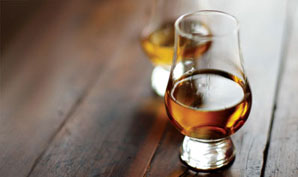|
Bartenders Guide: Scotch
“Whenever someone asks me if I want water with my Scotch, I say I'm thirsty, not dirty.” Scotch is the whisky embodiment of the French concept of terroir, which (when referring to wine) means that you could take the same grapes, ferment them in the same fashion and bottle them in the same way, but if you do it anywhere else, it's going to taste different. The Japanese are challenging my assertion, and they are making some fine products, but I'm sticking to my guns. The whisky made in Scotland is also the whisky made from Scotland, and that simply cannot be duplicated. The earthy smoke of peat, the briney mist of Islay air, the grain rolling in waves under darkened skies are in there, sometimes in a firm handshake on the palate, sometimes in a lingering kiss on the finish...but always the whole is greater than the sum of its parts. It's a bit sad then, that a Scottish Master Blender, whose educated palate can often detect more than 150 separate components in a whisky, spends more time sniffing his product (called nosing) than drinking it. Alcohol desensitizes the taste buds you see, and that simply must not be allowed. So, let's drink to those poor bastards, and their noble sacrifice.
Scottish whisky has a very strict legal standard, as defined by the Scotch Whisky Order of 1990* (UK) which states: It must be distilled at a Scottish distillery from water and malted barley, to which only other whole grains may be added. It must be processed at that distillery into a mash, converted to a fermentable substrate only by endogenous enzyme systems, and fermented only by the addition of yeast. It must be distilled to an alcoholic strength of less than 94.8% by volume so that it retains the flavour of the raw materials used in its production. It must be matured in Scotland in oak casks for no less than three years and a day. It may not contain any added substance other than water and caramel colouring, and may not be bottled at less than 40% alcohol by volume. Scotch whisky is divided into four distinct categories: Single malt Vatted malt (also called "pure malt") Blended Single Grain Scottish whisky is further characterized by the region in which each malt is made, although blends often contain several, sometimes as many as 100 different malts. The officially recognized regions are: Lowland, Speyside, Highland, Campbeltown and Islay (pronounced eye-lah). The Islands, an unrecognized sub-region, includes all of the whisky producing islands but excludes Islay. Click on the links above to find more in-depth information on each. Scotch is traditionally drunk neat, with an occasional splash of water to "open it up" and make the individual components more easily discernible. In the States, people commonly drink it on the rocks which is almost universally viewed as idiotic elsewhere, since the cold numbs the palate. It is interesting to note however, that the essential oils in a good quality Scotch will usually cloud over with the addition of ice, while one that remains clear is usually a sign that it has been over-refined, and the aromatic oils stripped away. *New legislation is underway at the time of this writing.
|





